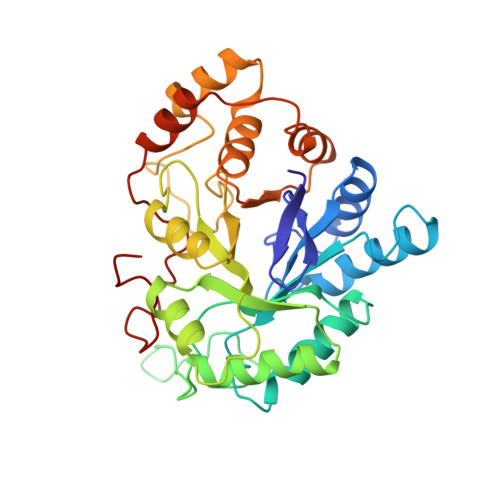An anion binding site in human aldose reductase: mechanistic implications for the binding of citrate, cacodylate, and glucose 6-phosphate.
Harrison, D.H., Bohren, K.M., Ringe, D., Petsko, G.A., Gabbay, K.H.(1994) Biochemistry 33: 2011-2020
- PubMed: 8117658
- DOI: https://doi.org/10.1021/bi00174a006
- Primary Citation of Related Structures:
2ACQ, 2ACR, 2ACS - PubMed Abstract:
Aldose reductase is a NADPH-dependent aldo-keto reductase involved in the pathogenesis of some diabetic and galactosemic complications. The published crystal structure of human aldose reductase [Wilson et al. (1992) Science 257, 81-84] contains a hitherto unexplained electron density positioned within the active site pocket facing the nicotinamide ring of the NADPH and other key active site residues (Tyr48, His110, and Cys298). In this paper we identify the electron density as citrate, which is present in the crystallization buffer (pH 5.0), and provide confirmatory evidence by both kinetic and crystallographic experiments. Citrate is an uncompetitive inhibitor in the forward reaction with respect to aldehyde (reduction of aldehyde), while it is a competitive inhibitor with respect to alcohol in the backward reaction (oxidation of alcohol), indicating that it interacts with the enzyme-NADP(+)-product complex. Citrate can be replaced in the crystalline enzyme complex by cacodylate or glucose 6-phosphate; the structure of each of these complexes shows the specific molecule bound in the active site. All of the structures have been determined to a nominal resolution of 1.76 A and refined to R-factors below 18%. While cacodylate can be bound within the active site under the crystallization conditions, it does not inhibit the wild-type enzyme in solution. Glucose 6-phosphate, however, is a substrate for aldose reductase. The similar location of the negative charges of citrate, cacodylate, and glucose 6-phosphate within the active site suggests an anion-binding site delineated by the C4N of nicotinamide, the OH of Tyr48, and the N epsilon of His110. The location of citrate binding in the active site leads to a plausible catalytic mechanism for aldose reductase.
Organizational Affiliation:
Department of Pediatrics, Baylor College of Medicine, Houston, Texas 77030.
















